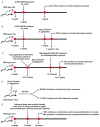Experimental in vivo and ex vivo models for the study of human aortic dissection: promises and challenges
- PMID: 28077990
- PMCID: PMC5209470
Experimental in vivo and ex vivo models for the study of human aortic dissection: promises and challenges
Abstract
Aortic dissection (AD) is a life-threatening aortopathy with high mortality. To mimic spontaneous AD, investigate the pathogenesis of AD and develop novel therapeutic targets and measures, multiple AD experimental models have been generated, including drugs or chemicals induced experimental models, genetically modified experimental models, surgically or invasively induced experimental models, and ex vivo models. However, the perfect model of AD that replicates every aspect of the natural disease has not be generated yet. This review provides an overview of the experimental models used in AD preclinical research. The value and challenges of each in vivo and ex vivo model are discussed.
Keywords: Aortic dissection; angiotensin II; experimental model; marfan syndrome; β-aminopropionitrile monofumarate.
Figures



References
-
- Erbel R, Aboyans V, Boileau C, Bossone E, Bartolomeo RD, Eggebrecht H, Evangelista A, Falk V, Frank H, Gaemperli O, Grabenwöger M, Haverich A, Iung B, Manolis AJ, Meijboom F, Nienaber CA, Roffi M, Rousseau H, Sechtem U, Sirnes PA, Allmen RS, Vrints CJ ESC Committee for Practice Guidelines. 2014 ESC guidelines on the diagnosis and treatment of aortic diseases: document covering acute and chronic aortic diseases of the thoracic and abdominal aorta of the adult. The task force for the diagnosis and treatment of aortic diseases of the european society of cardiology (ESC) Eur Heart J. 2014;35:2873–2926. - PubMed
-
- LeMaire SA, Russell L. Epidemiology of thoracic aortic dissection. Nat Rev Cardiol. 2011;8:103–113. - PubMed
-
- Golledge J, Eagle KA. Acute aortic dissection. Lancet. 2008;372:55–66. - PubMed
-
- Daily PO, Trueblood HW, Stinson EB, Wuerflein RD, Shumway NE. Management of acute aortic dissections. Ann Thorac Surg. 1970;10:237–247. - PubMed
-
- Debakey ME, Henly WS, Cooley DA, Morris GC Jr, Crawford ES, Beall AC Jr. Surgical management of dissecting aneurysms of the aorta. J Thorac Cardiovasc Surg. 1965;49:130–149. - PubMed
Publication types
LinkOut - more resources
Full Text Sources
